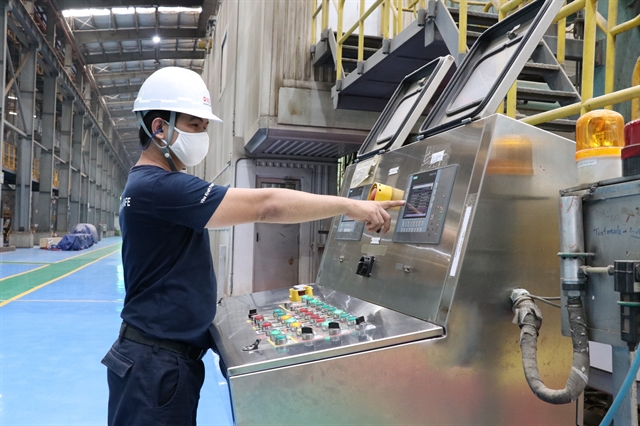 Economy
Economy

Foreign enterprises chose the southern key economic region as an investment destination, due to to its young and abundant labour force with lower wages other countries, and large consumer market

HÀ NỘI — Although the fourth wave of the pandemic negatively affected local production and businesses, the inflow of foreign investment to the southern key economic region increased significantly in 2021.
The region comprises HCM City and the seven provinces of Bình Dương, Bà Rịa-Vũng Tàu, Đồng Nai, Bình Phước, Tây Ninh, Long An and Tiền Giang.
Foreign enterprises chose the southern key economic region as an investment destination, due to its young and abundant labour force with lower wages than other countries, and large consumer market.
This year, HCM City was the locality most affected by the COVID-19 pandemic. After prolonged social distancing, the city still ranked third in attracting foreign investment with nearly US$3.74 billion, accounting for 12 per cent of the country's total.
Cao Thị Phi Vân, deputy director of the Investment and Trade Promotion Centre of HCM City (ITPC) attributed the city's position in term of foreign investment to its great efforts in accelerating administrative reforms, simplifying business conditions and improving the quality of civil servants to better facilitate the business community, Tiền Phong (Vanguard) newspaper reported.
In anther bright spot, over 96 per cent of the 1,412 enterprises in HCM City Export Processing Zones and Industrial Parks (HEPZA) have resumed their operation and 80 per cent of their employees have returned to factories, Hứa Quốc Hưng, head of the management board of HEPZA said.
The stability in economic management in HCM City over the past month has helped encourage foreign investment inflows back to the locality, Hưng said, adding that after the social distancing period, a number of foreign investors worked with HEPZA.
As of last year, the city was home to 10,434 valid foreign-invested projects with capital totaling $49.47 billion.
Meanwhile, Bình Dương Province ranked 4th among 59 localities in the country in terms of foreign investment attraction with over $2.13 billion in 2021. Thus far, the southern province has 4,021 valid foreign-invested projects with a total registered capital of over $37.17 billion.
Director of Bình Dương Department of Planning and Investment Mai Bá Trước told Tiền Phong that the positive inflow of foreign investment helped the province overcome difficulties to realise "dual goals" in 2021.
These were a 4.3 per cent year-on-year growth in its industrial production index and yearly rises of 13.5 per cent and 14.7 per cent in its export and import turnovers to $31.5 billion and $24.6 billion, respectively, resulting in a trade surplus of $6.9 billion.
Similarly, Long An Province was the second locality in attracting foreign investment in 2021 with over $3.84 billion, accounting for 12.3 per cent of the total investment capital of the country. Of the sum, over $3.51 billion came from 54 newly-licensed projects; $255 million from 65 existing projects to raise their levels of capital while the remainder of investment from capital contribution or share purchase was made by foreign investors.
Đồng Nai Province in 2021 surpassed the yearly target with over $1.35 billion investment. During the year, the province licensed 51 new projects with a total registered capital of $295 million. It also allowed 49 operating projects to add $470 million to their capital and approved $597 million worth of capital contribution and share purchases of foreign businesses in a total of 87 transactions.
Đồng Nai has to date attracted 1,792 foreign-invested projects with a total registered capital of nearly $32.7 billion. Most of these projects came in processing and manufacturing, textile and footwear industries.
The newspaper cited Nguyễn Thị Hoàng, deputy chairwoman of Đồng Nai Province People's Committee as saying that many countries around the world now had policies to reopen their economies, and this would be an opportunity for foreign enterprises to accelerate their overseas investments.
Hoàng said her province would concentrate on calling international enterprises to develop their projects in the province and contributing to its economic development. Top priority would be given to businesses with projects in supporting industries, high technology and clean technology rather than labour-intensive projects.
The deputy chairwoman added that local authorities would create the most favourable conditions for businesses by shortening the time used for fulfilling procedures related to investment, production and export.
Bà Rịa-Vũng Tàu, another province in the region also experienced a positive foreign investment inflow last year.
From January to December, the provincial Industrial Park Authority granted licences to 13 foreign-invested projects worth $207.76 million. It also approved 25 existing projects to raise their capital by $268 million. Most foreign-invested projects in the province were large-scale, with average registered capital of about $103 million per enterprise.
Nguyễn Anh Triết, head of the authority, said the foreign investment registered in the province last year exceeded the plan set for the year. He attributed the result to the province's efforts to improve its business and investment environment.
However, Triết said that Bà Rịa-Vũng Tàu would not attract investment at all costs. Top priority would be given to projects in hi-tech industries and those that were environment-friendly, and less so in labour-intensive industries. — VNS




